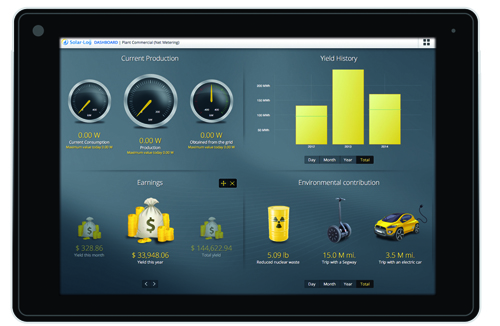Waste Not, Want Not: Intelligent solar monitoring save energy costs
 A hungry rat scurries beneath a solar array and chews through the cables. Strong winds scatter debris across the modules. Lightning strikes an inverter, causing it to fail. These things happen. When they do, solar monitoring systems notify the installer or system owner that something has gone wrong.
A hungry rat scurries beneath a solar array and chews through the cables. Strong winds scatter debris across the modules. Lightning strikes an inverter, causing it to fail. These things happen. When they do, solar monitoring systems notify the installer or system owner that something has gone wrong.
Modern monitoring systems do much more. Today’s systems can even control the amount of onsite consumption generated by photovoltaic (PV) power, thereby significantly increasing the financial returns for plant owners.
But what if a problem is coming from the electric grid, not from a PV system? Consider a residential system that could feed 8 kilowatts (kW) of power into the grid at a time, when the utility accepts no more than 7 kW. In this example, the inverter output is reduced to 7 kW, while the system is losing over 12% of its output. No repair to the solar modules or inverters can fix this problem.
A modern monitoring system can make a difference, however, by controlling the inverters to produce the amount of power that satisfies the onsite power consumption need, as well as the utility power limitation demand.
Today’s monitoring systems have the ability to measure home energy consumption, in addition to solar energy production. They can control whether a PV system sends energy to the grid, or straight to the home. Innovative monitoring systems can even switch on additional electrical devices, depending on the amount of PV power generated. With such capabilities, these systems can also respond to utility limits in regards to how much energy can go to the grid by diverting excess energy to home appliances, such as electric heaters.
A PV system, therefore, can generate exactly the amount of power that can be used in the home or sent to the grid, maximizing the return of investment (ROI) for plant owners.
German technology
Power management has become an important feature in Germany because of how PV systems are financed, and because of the country’s large amount of solar PV power, which is available to feed into the grid.
As solar costs have come down, the German government has reduced the tariff that system owners receive for their output, known as the feed-in tariff. Today, the tariff for a kilowatt-hour (kWh) of solar production is about half of the rate for 1 kWh paid for consumption. Given a choice between feeding energy into the grid and consuming it at home, system owners are better off using the energy themselves.
More utility control had been necessary to maintain the stability of the grid, as more and more PV capacity has come online in Germany. As a result, utilities have received the authority to limit the amount of power that can be fed into the grid.
There are three sets of regulations based on system size:
- For systems over 100 kW, the utility has total control of output;
- For systems between 30 kW and 100 kW, the utility regulates output in four stages: full power; 60% of capacity; 30% of capacity; and no power;
- For systems under 30 kW, the utility caps output at 70% of capacity.
These limitations haven’t made the job of selling PV systems any easier. But systems don’t ordinarily feed 100% of their rated capacity into the grid, even during the sunniest parts of the day. Temperature affects output, as does cloud cover and soiling on the solar modules. Normal output rarely goes well beyond 80% of capacity.
Nevertheless, German residents are paying almost 0.27€ per kWh for electricity—equivalent to about 37¢, or about three times the average residential rate in the United States. Therefore, it’s much preferred to use their excess energy rather than waste it. Intelligent monitoring enables them to do so.
Monitoring features
Monitoring systems usually use a device called a datalogger to capture PV system output. The datalogger checks for system faults by comparing inverter or module string output against other inverters, other module strings, or measurements from an irradiance sensor. Systems typically report actual production in daily, monthly, and yearly increments for the operating life of the system. They can also report the value of energy produced, according to the local currency and carbon dioxide offset, by producing solar energy instead of energy from fossil fuels.
Some dataloggers have an onboard display, which shows all the key indicators using simple graphics and tables. Most connect to the Internet through a modem or a wireless card, so results can be downloaded to a home computer, synced to a website, or displayed in smartphone apps. The online portal allows users to check each inverter’s performance characteristics, including efficiency, operating temperature, and the metrics that influence overall PV system efficiency.
An intelligent monitoring system constantly calculates the limit on energy that can be fed into the grid. Once PV output reaches this limit, a smart system is able to make excess energy available for onsite consumption.
This can work in two different ways. In one scenario, PV power goes up to the utility limit, and then stops until a home appliance starts drawing power. Let’s say the cap is 7 kW and the home appliance is a 1,500-watt electric heater. Once the heater comes on, PV power can go up to 8.5 kW.
Using a different configuration, the system automatically turns on appliances, based on the amount of energy produced. For instance, it can turn on electric water heaters when the PV system is working and keep them running throughout the day. If solar output increases further, air conditioners come on next. Appliances can stay on for a minimum run-time, or they can switch off once solar output drops below a certain level. The system can also switch on appliances at set times, whether energy comes from the solar system or the grid.
The modern monitoring features are also useful for investors to operate larger PV systems, by carefully managing the amount of power used by their own energy supply system or fed-in into the public grid, depending on the cost/price metrics.
Future gains
A lot has to change for the US to see a sizable increase in onsite consumption of solar energy. For one, new regulations would be necessary to move away from net-metering—where it doesn’t matter financially for the PV system owner if the generated PV power is consumed onsite or fed into the grid. For utilities, however, it matters, because the fed-in power can cause large investments into upgrading the grid infrastructure, as well as new grid management systems.
Generally, the incentive for increased onsite PV power consumption is greatest either when utilities limit the amount of power that can be fed into the grid, or when the feed-in tariff is significantly lower than it costs to buy the power from the grid.
High retail electricity rates (such as in Hawaii, where energy costs are on par with Germany) also play an important factor in making investments for controlling onsite PV consumption economically viable. For this to work, however, homes with electromechanical meters would have to switch to bi-directional readable digital meters.
Countries that adhere to IEC standards, including the US, will soon begin regulating communications between grid operators and decentralized power plants. The latest standard, IEC 61850, specifies a general transmission protocol for electrical switching systems
Performance monitoring by reporting PV system failures in real-time, and thereby enabling fast recovery to normal operations, has become an essential part of modern PV plants. In Germany, this is no longer enough. And, before long, the same will be said for the US. PV power generation is growing so rapidly, maximizing the onsite use of self-generated solar power and grid management issues, is becoming more significant to save costs and to save energy from waste.
Anton Kaeslin is president of Solar Data Systems, Inc., a fully owned subsidiary of Solare Datensysteme GmbH of Binsdorf, Germany. Kaeslin has served as a senior executive for multiple international telecommunications and renewable energy companies.
Solar Data Systems, Inc.
www.solar-log.com
Author: Anton Kaeslin
Volume: November/December 2014










.png?r=2949)

